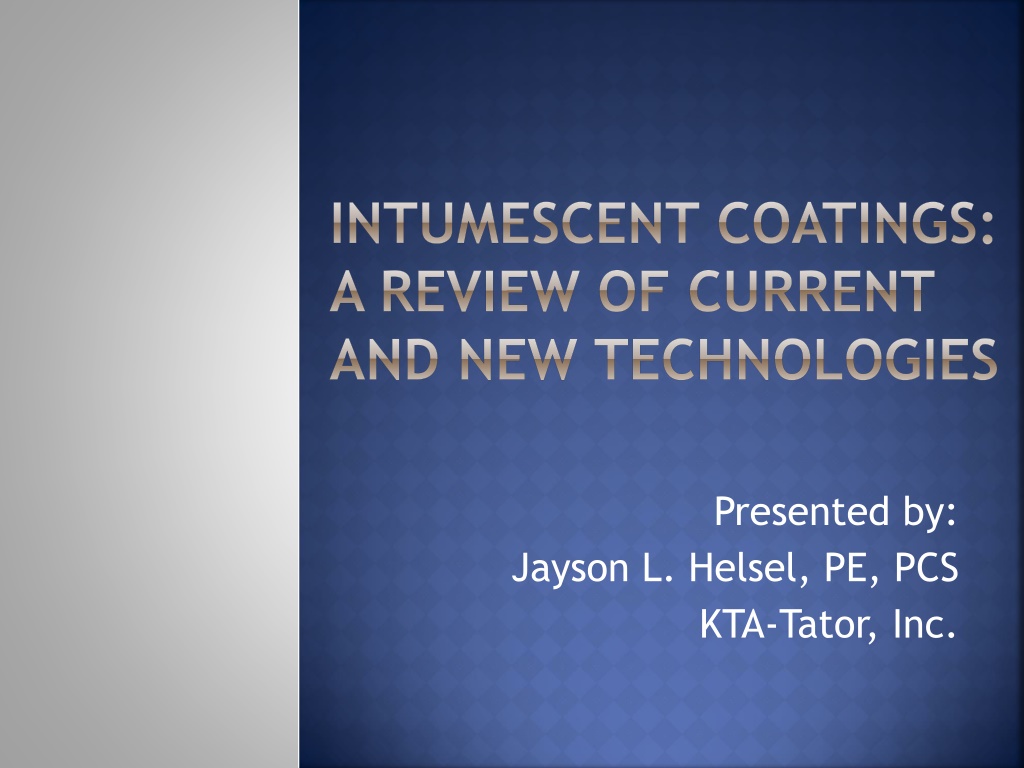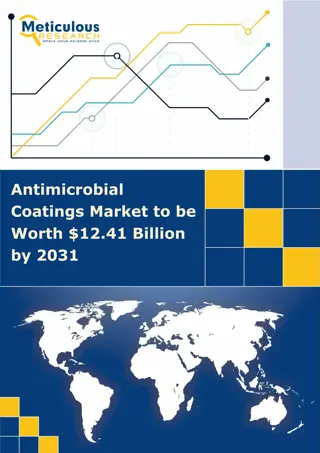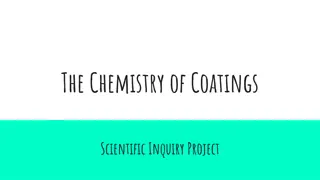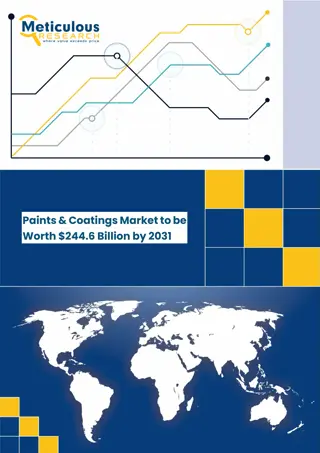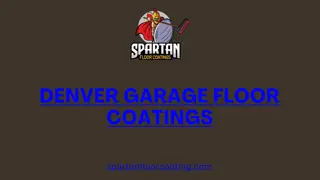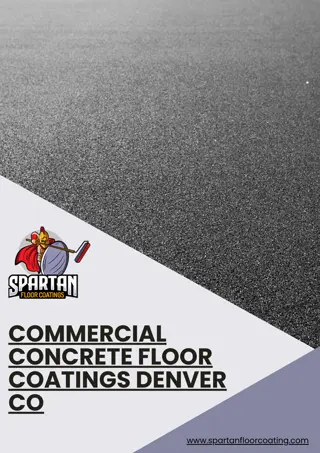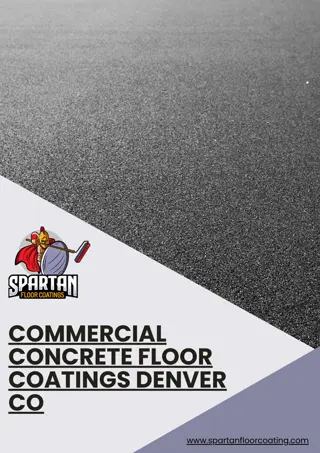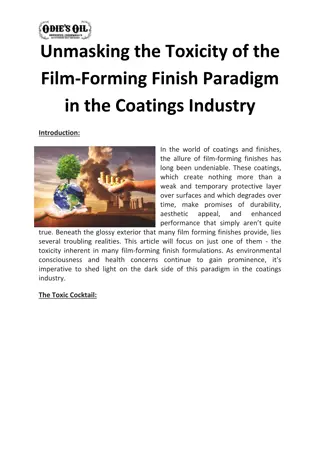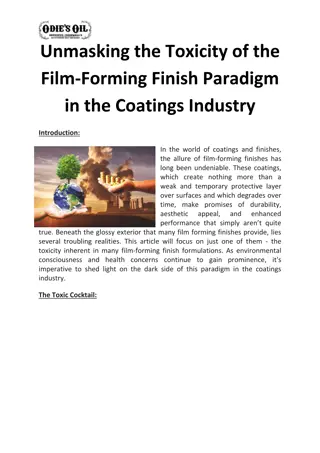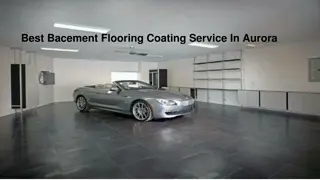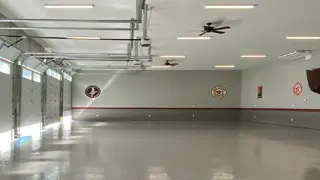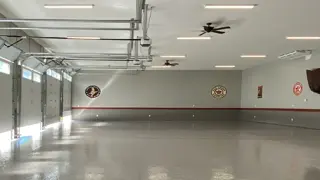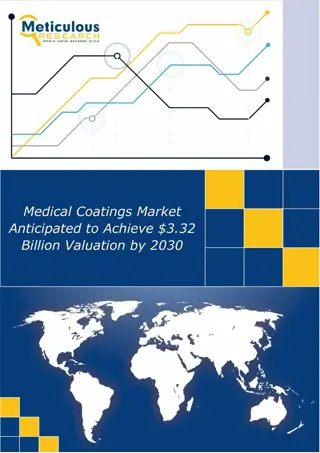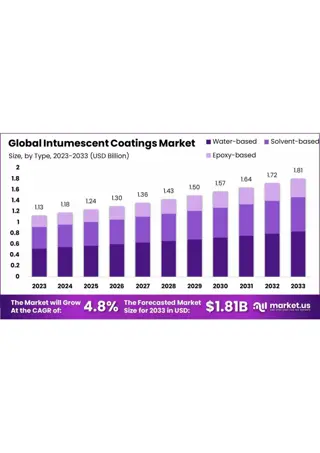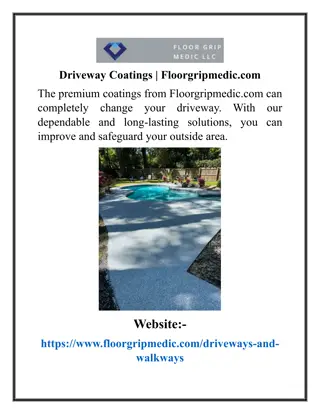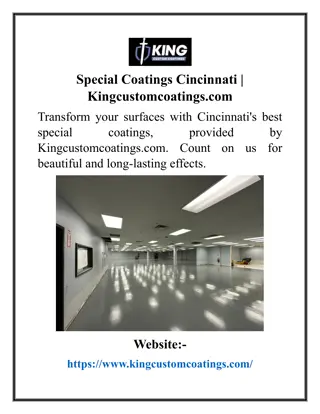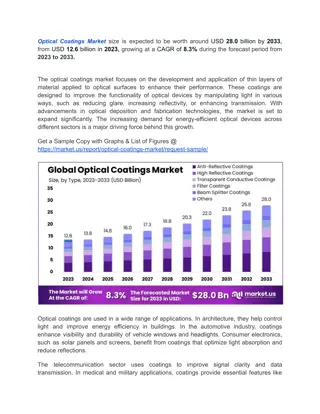Understanding Intumescent Coatings: A Comprehensive Overview
Explore the world of intumescent coatings through a detailed review of current technologies and new advancements. Learn how these specialized coatings protect steel structures from heat exposure, the classification tests they undergo, resin types used, methods to improve their texture, and ways to measure hardness for proper curing assessment. Discover how intumescent coatings function, their performance ratings, and the importance of fire resistance classifications from authorities like Underwriters Laboratories (UL).
Download Presentation

Please find below an Image/Link to download the presentation.
The content on the website is provided AS IS for your information and personal use only. It may not be sold, licensed, or shared on other websites without obtaining consent from the author. Download presentation by click this link. If you encounter any issues during the download, it is possible that the publisher has removed the file from their server.
E N D
Presentation Transcript
INTUMESCENT COATINGS: A REVIEW OF CURRENT AND NEW TECHNOLOGIES Presented by: Jayson L. Helsel, PE, PCS KTA-Tator, Inc.
LEARNING OBJECTIVES Comprehension of the webinar will enable the participant to: Describe how intumescent coatings protect underlying steel from heat exposure Identify a US authority that evaluates and approves intumescent coatings List two fire rating classification tests that are used to qualify intumescent coatings for use in building/facility construction Identify two primary resin types that are used to formulate intumescent coatings Describe the methods used to improve the appearance of the texture of intumescent coatings Describe a method to measure the hardness of the applied coating to assess cure
INTUMESCENT COATINGS Sprayed Fire Resistive Materials (SFRM) are broad group of materials including: Cementitious and gypsum based materials Intumescent coatings (Note: There is a separate category for Fire Retardent coatings, which are not reviewed here)
INTUMESCENT COATINGS Intumescent Coatings: Are categorized as SFRMs Similar to conventional coatings Have unique fire resistant properties
INTUMESCENT COATINGS How they function: Intumescent coatings char and swell when exposed to fire/heat The charred layer acts to insulate the steel from fire
INTUMESCENT COATINGS Performance ratings Coatings rated by how long steel is protected at specified thickness Ratings from 1 to 3 hours (at 30 minute intervals Specific to shape/size of steel, e.g. W10 x 49 column
FIRE RESISTANCE CLASSIFICATIONS Underwriters Laboratories (UL) is recognized US authority that evaluates and approves intumescent coatings for a certain classification and fire rating Certifications can be verified online at www.ul.com
INTUMESCENT APPROVALS Certifications are design specific by coating manufacturer Numbering system defines an alphanumeric design number
INTUMESCENT APPROVALS Beams W, M or S shaped steel sections (AISC) Minimum beam size for fire resistance is expressed as W/D ratio W = weight of beam per lineal foot D = perimeter of protection material Beams of same configuration with greater W/D ratio may be used in design
INTUMESCENT APPROVALS Columns Minimum column size and configuration specified in X and Y series designs Same hourly rating applies when section with equal or greater W/D ratio is substituted for same configuration
INTUMESCENT APPROVALS Beams and Columns Required coating thickness increases as weight of steel decreases Lighter steel heats up more rapidly and requires more protection
INTUMESCENT APPROVALS Intumescent (and Mastic) Coatings Coating thickness specification in a design is minimum average thickness measured in accordance with Technical Manual 12-B Average thickness should not exceed maximum thickness published (if listed) in individual designs or by No individual measurement <80% of specified design thickness
INTUMESCENT APPROVALS Technical Manual 12-B Published by Association of the Wall and Ceiling Industries (AWCI International) Individual measurement = average of 3 gauge readings (similar to SSPC-PA 2) Testing frequency one bay per floor or one test per 10,000 square feet (further defines required shapes)
INTUMESCENT APPROVALS Technical Manual 12-B Scope General Information Substrate Conditions Site Conditions Inspection Procedures Method of Tests Conditions of Finished Application Patching
FIRE RESISTANCE CLASSIFICATIONS ANSI/UL 263 Used for resistance to cellulosic fire (e.g. combustion of wood or building materials) Slower rise in temperature 1000 F at 5 min.; 1550 F at 30 min.; 1700 F at 60 min.; 1925 F at 180 min.; 2000 F at 240 min. Interior and exterior exposures
FIRE RESISTANCE CLASSIFICATIONS ANSI/UL 263 Classified Coatings Typical use for structural steel in commercial structures
FIRE RESISTANCE CLASSIFICATIONS ANSI/UL 1709 Used for resistance to a hydrocarbon fire e.g. petroleum fuel Rapid rise in temperature 2000 F at 5 minutes Interior and exterior exposures Environmental tests include, accelerated aging, high humidity, salt spray, thermal cycling for exterior exposure
FIRE RESISTANCE CLASSIFICATIONS ANSI/UL 1709 Classified Coatings Typical use for steel structures at petrochemcial facilities, e.g. Chemical plant Refineries Offshore oil platforms
OTHER APPROVALS Intumescent coatings may also need approval by city building codes Coating manufacturers should provide approvals as applicable
GENERIC COATING TYPES Intumescent coatings are generally the following generic resin types: Acrylic/vinyl Epoxy Intumescents are also generally categorized as thin-film or thick-film coatings
GENERIC COATING TYPES Acrylic/vinyl Thin-film coating Solvent or water-based Single component Typically rated under UL 263
GENERIC COATING TYPES Acrylic/vinyl Applied in several coats Time-frame for a complete application may span several days Additional time may be needed before application of any required exterior finish coat.
GENERIC COATING TYPES Epoxy Thick-film coating Applied by plural component spray equipment in one or two coats Rapid cure Typically rated under UL 1709
GENERIC COATING TYPES Epoxy May require mesh reinforcement (e.g. metal, fiberglass, carbon) Typically requires the use of applicators licensed or approved by the coating manufacturer
GENERIC COATING COMPARISON Coating Type Required Thickness (mils) Number of Coats Recoat Time @50 F Time to Finish Coat @50 F Solvent-based acrylic Solvent-based vinyl Water-based acrylic Epoxy 130 5 24 hours 25 days 375 4 4 hours 20+ days 180 6 8 hours 10+ days 180 1 n/a 24 hours Epoxy w/mesh 340 1-2 n/a 48 hours
TESTING FOR COATING CURE Intumescents may require testing for adequate cure Typical test is Durometer Hardness (Shore D) Resistance of coating film to indentation by Durometer instrument ASTM D2240, Standard Test Method for Rubber Property-Durometer Hardness
COATING APPEARANCE Intumescents generally have a rough or orange peel appearance Methods to improve include: Back rolling following spray application Sanding (not recommended) Finish coat application (may be required)
COATING SYSTEMS Intumescent design approvals typically include a primer and/or finish coat When included in design primer/finish must be applied to meet fire rating Primer/finish must be endorsed by intumescent coating manufacturer Preference always for same manufacturer
USE OF PRIMERS Intumescent coating manufacturer may have approved list of primers Types include alkyd, acrylic, epoxy and zinc-rich Application thickness important
PRIMERS Function of primer Provides adhesion to substrate Provides suitable surface for intumescent Provides additional barrier protection Can also provide inhibitive or sacrificial protection
USE OF FINISH COAT May be required in design approval for exterior exposure Intumescent coating manufacturer must endorse finish material Types include 100% acrylic and aliphatic urethane coatings May affect/improve appearance
FINISH COATS Function of topcoat Color and gloss Abrasion resistance Chemical resistance Washability Resistance to the environment
FINISH COATS Acrylics Advantages Single component Ease of application Color & gloss retention Flexibility Low VOC content for waterbased
FINISH COATS Acrylics Limitations Limited alkali and solvent resistance Moderate abrasion resistance Application temperature >50 F for waterbased
